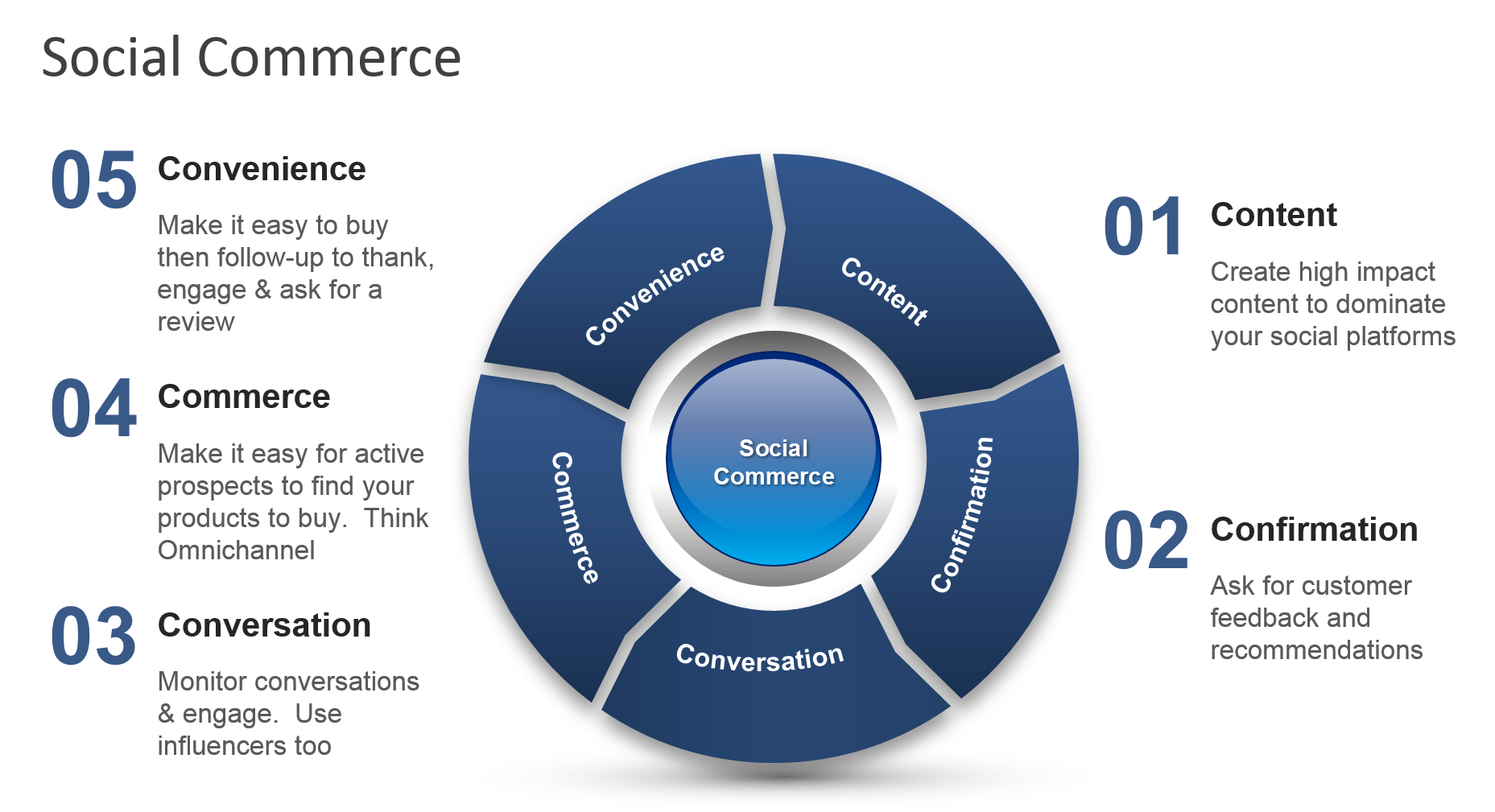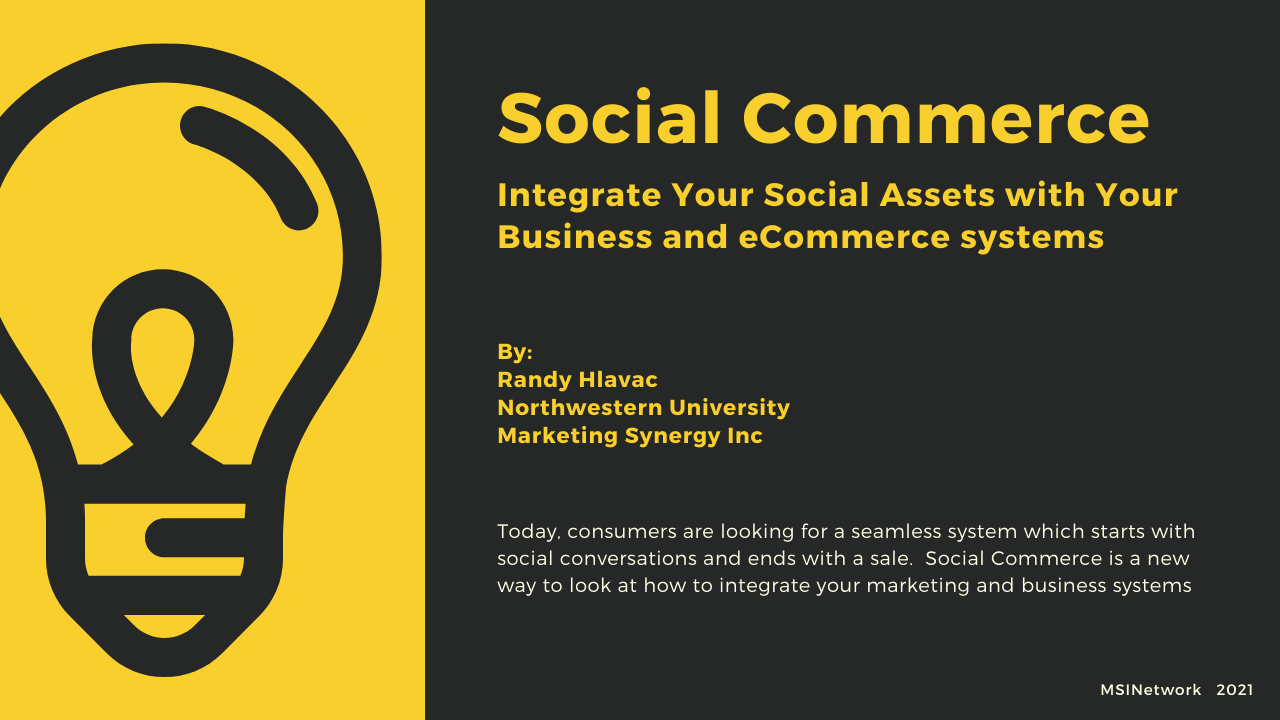In the past, most businesses developed their social assets separate from their commerce systems. While CMOs realized they were linked, it wasn’t really necessary to connect the two. Social followers and visitors would be enticed by the company on social and would eventually link to the company’s business systems to make a purchase. But the pandemic changed all that. With most purchasing being done online, consumers were attracted to companies who made it easy to find out about their products and services and then seamlessly link to purchase them. In addition, companies were using influencers to use social to directly speak to the audiences they wanted to attract and, once successful, used the influencers for longer-term engagements. In turn, the influencers needed to direct their followers to a trackable system to make their purchases.
In China, they pioneered a strategy called Social Commerce. It coordinates content, conversation and influencer programs seamlessly with the business commerce platforms. The Social Commerce strategy recognizes the relationship most consumers today have with their social sites. They are not adjunct to the marketing process but integral to it. Today, you need to consider this relationship as consumers – both business and personal – become more reliant on social networks, customer reviews & influencer recommendations to make their purchase decisions.

Content – In the post-covid “new normal” marketplace, consumers are doing – as Forbes reported in March 2021 – “revenge shopping”. They are now focused on moving ahead with their lives as the world “opens up”. However, while they are looking to spend, more and more are making their purchase decisions and actual purchases online. While they might go out to shop, the convenience and speed of online today makes it a very viable – and somewhat safer – alternative. In Social Commerce, here are several areas you should explore in building your social media marketing strategies:
- Better Understand the Needs of Your Target Audience – Today, your target audience is talking to each other about your products and services. You need to better understand what they are saying. Find communities where they congregate to see what they are discussing. You can find consumer groups on sites like Facebook and professional communities on sites like LinkedIn. Identify key influencers who are talking to these communities, follow them, and see what they are discussing and the hashtags they are using. To get started, try Followerwonk to search for topics of interest to your high value target markets.
- Create Feature & Benefit-oriented Content to Motivate – While some of your content should be helpful, in today’s post-covid marketplace, consumers are trying to make up time following the pandemic. Don’t be too shy. Create more sales oriented programs designed to communicate the high value features of your products or services and the benefits they will provide to your target audience. Consider developing unique marketing programs for each high value audience and tailor them for each social platform you are using. Use hashtags to directly link to audience prospects.
- Consider Using Influencers on High Value Platforms – Influencers have already attracted your high value audiences. Consider working with them to create programs designed to show their followers your products and services. Train them to best show your products and answer questions but let them be creative in how they promote them. They are the experts. Haven’t done influencer marketing? I recommend you start with IZEA and their excellent videos and case studies.
- Market to Dominate Your Social Platforms – This is key. For every content item you create, you need 10 – 20 promotional messages to connect with your target audience. Remember, only a small percentage of them are online at any given time. In addition, create PPC and paid advertising on key social platforms. You need to dominate these platforms during your promotional efforts to ensure your markets are aware of you and your brands.
Confirmation – Today, consumers look for reviews, ratings and community conversations about your products and services. They want to confirm they are making a good purchase decision. You need to incorporate reviews and ratings into your digital marketing strategy.
- Ask for Feedback – Today, 92% of consumers AND B2B buyers are using online reviews to make their purchase decisions. You need to develop a way for new customers to let you and your target markets know what they think of your products and services.
- Respond to Bad Reviews – Bad reviews are normal. If you get one, follow up on it immediately. Resolve the issue and ask for a new review. While consumers don’t trust a company with all 5-star reviews, they don’t trust one with too many bad reviews. Monitor reviews and act on the bad ones.
- Consider Developing eCommerce SKUs & Benefit Copy – Your high value audience engages on different social media sites for different reasons. Consider developing SKUs and benefit copy for each unique site. The more you can tailor the experience to each site, the more seamless it will be for your prospects.
Conversation – Consumers want to do business with a company that listens and responds to them. Whether it is a positive comment or a complaint, they want it handled in real-time and with urgency. Failure to handle problems results in a crisis for you.
- Monitor conversations – There are social monitoring systems which allow you to both monitor all of your social sites but also to respond to prospects in real time. I use & teach Social Studio from SalesForce. It is amazing to see people talking in real-time. It’s a real learning opportunity and a great way to see how they are engaging with each other on topics of importance to them.
- Respond to opportunities – If someone complains, respond to them immediately. If someone posts great things about your company, thank them. Consumers want companies that listen and respond to them.
- Train influencers – If you use influencers, be sure they are trained on your products and services. They will often be asked questions and need to be able to answer them or refer them to your help center.
Commerce – Online commerce should be a part of your social conversation. Tailor your products and services toward the unique communications on each of your social assets to make the process seamless.
- Be consistent – Be sure your pricing, guarantees and other aspects of your products and services are consistent across all of your social channels. Remember, people will be talking to each other so consistency is a must.
- Create copy best suited to each eCommerce SKU – Audiences are different and use different social sites differently. Create copy and benefit sells to each unique audience by site.
- Be Customer Focused – Be sure to talk directly to your prospects. They expect companies to be human, engaging, and focused on their needs, wants and aspirations.
Convenience –
- Fulfill your Product Promises – Be sure to follow through on all orders to ensure timely delivery. The order is just the start of the process.
- Thank You’s are Important – When you attract a new consumer, be sure to thank them. These messages cement the relationship and lay the foundation for future discussions.
- Make it Personal – If possible, assign a specific individual to each new customer and empower them to ensure they are thrilled to have purchased from you.
- Plan Your Follow-up – Structure the post-purchase funnel to maintain contact with your new customers. Plan the Thank You and the Request for a Rating the same as your marketing programs. They are critical to your success.
Today, you need to integrate your social media with your commerce systems to best serve your prospects, leads and customers in this post-pandemic marketplace.

